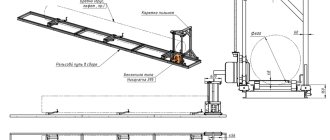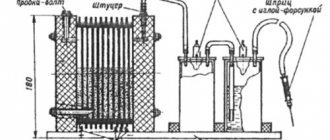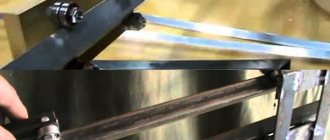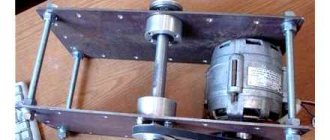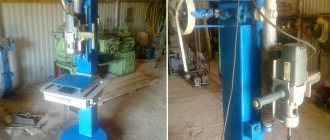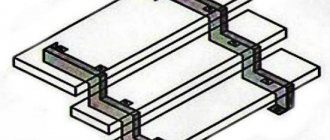Purpose of the tire sawmill
Table for correct cutting of wood on a tire sawmill
Human life requires wood of different species, each for its own purpose. It was once processed exclusively with axes and hand saws. They were replaced by chainsaws and woodworking machines.
The equipment is constantly being modernized, and more and more convenient modern machines are appearing. These include tire sawmills. They cannot replace other machines, such as a rounding machine or a crown cutter, but they perform their functions in wood processing successfully.
If you plan to build a country house or dacha made of wood, then you will need quite a lot of material. And if there is a forest nearby and there is an opportunity to stock up on it, then it is best to make a tire sawmill with your own hands to process it and make building materials.
Making a sawmill with your own hands will help solve any problem related to wooden products: make a barn or a bathhouse, a gazebo, a log house.
A self-made tire sawmill can produce:
- high-quality sawing of logs in the longitudinal direction;
- on it you can give the logs the same shape and size;
- cut them into boards, beams, slats, and many other elements.
A homemade tire sawmill produces small batches of non-standard wooden blanks and processes wood of different species.
The tire sawmill is designed for processing different types of wood
Types of tire sawmills
The simplicity of the saw bar design allows it to be used with any drive. Therefore, tire sawmills are divided according to the type of engine:
- gasoline, with a four-stroke internal combustion engine;
- electric, with a high-power three-phase asynchronous electric motor.
Installing an electric motor as a power unit makes sense if the sawmill is intended to be used as a stationary device. Due to the fact that the sawmill is used, as a rule, outdoors, it would be preferable to equip it with an asynchronous motor.
An electric sawmill requires significant energy consumption, so it is necessary to install a motor with a power of at least 3 kW. Naturally, to power such a powerful machine you need a cable with a large cross-section of wires. When longitudinally sawing logs using an electric sawmill, it should be taken into account that in this mechanism the working element is movable and can move over a distance of up to 6 m. Ensuring normal operation of the mechanism in such conditions requires that the cable be not only powerful, but also well insulated. At the same time, it must be flexible and mobile.
The gasoline engine installed on the tire sawmill relieves the operator of worries with the cable, thereby increasing the mobility of the sawmill. But the gasoline engine also has its drawbacks. For example, if a car is equipped with a regular gasoline engine, then a battery is needed to start it. If a chainsaw drive is installed, then you need to be prepared to start the engine with a regular recoil starter.
Placement and design of tire sawmills
To install a tire sawmill, you do not need a large area. It can be installed in a small area.
Created with your own hands, it can be stationary, in which an electric motor is installed, or mobile (using a gasoline engine). This will allow sawing equipment to be moved to any location, including the production of lumber in the forest.
They make the following designs for tire sawmills with their own hands:
External view of a bus sawmill with an electric motor
- With the movement of the working unit along the processed tree.
- With a longitudinal method of feeding wood to the unit.
The advantage of the first type of tire sawmill is the control over the working unit throughout the entire section along the log. This ensures uniform cutting and high speed.
In the second case, control over sawing is more complex. A strong push from the tree can cause the chain to jam or the engine to overheat. The advantage is the absence of a large number of electrical wires moving behind the unit.
Design Features
We can assume that the tire sawmill has acquired its final appearance and is ready for sawing wood. Don't rush and don't expect to do everything perfectly quickly and accurately. The sawmill must undergo further testing, and the operator must learn to work on it. On this path, certain negative aspects may await you:
Sawmill electric motor connection diagram.
- The tire sawmill is heavier at the top. The center of gravity at a high altitude causes strong deviations in the direction of the tire. The lumber will have a noticeable “waviness”. The vibration is felt very strongly by the operator. There are two options: either place the engine lower from the sawmill, or increase the weight of the lower part.
- The sawmill moves along the guides only with great effort from the operator. If the wheels of the sawmill do not have excessive friction with the guides, then the cause of the inconvenience lies, again, in the location of the center of gravity. The design needs a counterweight to the engine.
- When sawing, the chain stops. A common occurrence when the clutch is adjusted incorrectly. You just need to tighten the clutch rollers or shorten the cable.
Initially, tire sawmills were made on the basis of a chainsaw.
This caused a number of serious inconveniences. Feeding wood and operating the chainsaw accelerator was only possible with the participation of two people. The design of the sawmill described above allows one person to work successfully on it. By moving the cutting part of the sawmill, the operator sees all the moments of sawing and can independently adjust the speed of feeding the bar onto the tree trunk. Typically, it takes about 5 minutes to cut a 4-meter log. A chainsaw will do this job a little faster, but the quality of the cut will not be as smooth as when using a tire sawmill.
Read also: Do-it-yourself manual circular grinder from an angle grinder
A chainsaw sawmill can have a stationary tire arrangement. In this case, the log itself is served. It is not necessary for several people to be present. Supply is ensured through the use of chains from agricultural machinery. Such a chain is fixed to a movable cart on which the log is located. The chain is attached to sprockets, one of which should be located next to the operator and have a handle for rotation. Such homemade products work no worse than others. The only drawback is that such tire sawmills require additional load on the person’s hands and certain sawing skills.
Components of a sawmill
The working unit consists of:
Sawmill drawing
- Beds:
- tires;
- electric motor;
- clutch mechanism.
The cutting tool here is a chainsaw chain bar. When using a chain saw designed for longitudinal sawing for the sawing mechanism, the cutting surface is guaranteed to be smooth.
The power unit is a three-phase electric motor with a power of 5.5 kW or a four-stroke gasoline engine with a power of 5.5 horsepower.
The basis of the sawmill is a frame along which a mobile trolley with a saw mounted in a horizontal position moves. The base must be of high quality to reduce vibration.
Bed design:
- two steel channels or rails 8 meters long and 14 cm high;
- Along the entire length of the channel, ties made from sections of metal pipe are installed;
- holes are made in the channels and ties are installed in them every 1–1.5 meters.
Sawmill diagram
Homemade sawmill: maintenance features
Tire sawmills are no different in maintenance from a regular chainsaw. The tire (drive sprocket) requires oil supply, otherwise it may simply jam. The chain needs regular sharpening. Tire sawmills operate in very tight conditions, so you should not buy cheap chains for them, as they will quickly fail or will have to be constantly sharpened.
It is better to choose an expensive brand-name chain with a hardened cutting edge. It will last a very long time and is unpretentious to wood. Tire sawmills should not be used for the production of lumber from dry tree trunks that have a high density. This sawmill works successfully when sawing raw pine, alder, and birch.
Residents of small towns or villages are well aware of the role any woodworking equipment plays in their lives, which most likely many have had to use in their work. Nowadays, the construction market is replete with a large number of different models of woodworking equipment, with sawmills being the most popular. All sawmills are divided into frame, disk and band sawmills, which differ in the type of cutting tool. The tire sawmill differs radically from them in its design.
Content:
Purpose of the tire sawmill
Man has long been using wood of different species to make objects that are necessary for his life. During this time, people worked to modernize woodworking equipment. Hand saws, which were used in the past, have practically sunk into oblivion. They have been replaced by more modern and convenient machines, which include a chainsaw, multi-saw and edger, as well as tire sawmills.
Any construction or maintenance of buildings is accompanied by large financial expenses, which is associated with wood processing: sawing timber, preparing boards, manufacturing rafters, beams or furniture parts. All this, of course, you can purchase at retail in a retail chain, but when you buy a new tire sawmill, all expenses will quickly pay off, and with the help of your own woodworking machine you will build a house, a bathhouse, a garage, a country house and a summer gazebo.
The main purpose of a homemade tire sawmill is high-quality longitudinal sawing of logs of any type of wood for the production of unedged and edged boards, veneer, slats, carriages, beams and sawing of thin gauges. Sawmills of this type are designed for the production of small batches of lumber, processing of non-standard logs and obtaining special sizes of workpieces.
Tire sawmills do not require a large area for installation and can be freely installed on a limited plot of land. Of course, a chain sawmill will not replace a cylinder saw or a crown cutter, but you can cut timber and make boards with your own hands. In the photo of tire sawmills, you will see that there are machines that operate from an electrical network and are stationary installations, as well as autonomous options that run on gasoline, with which you can go into the forest and harvest the necessary lumber.
Construction of a bus sawmill
The sawmill consists of a frame, clamping stops, a movable trolley, rollers, a carriage, an electric motor, a tire and a chain saw. The sawmill frame is lightweight, so it can be transported in the trunk of a car. The tire sawmill can be relatively easily moved and installed in close proximity to the log that is being cut - in a lumber yard or construction site.
You can saw logs of almost any length on a tire sawmill. And if you provide for the additional installation of another section in the drawing of a homemade tire sawmill, then you can increase the length of the log by another couple of meters. This is considered very beneficial when constructing a house or country house for the production of floors.
The design of the clamping stops is quite simple and convenient. Two clamps are located at the end and beginning of the log; the log is pressed against the stop flags with screws. During the sawing process, you can lower the stops to the appropriate level.
The movable trolley can be mounted from a steel plate, which has a thickness of 5-6 millimeters. It is equipped with a steering wheel and a thrust angle. Then it is placed on rollers or bearings. You can use a chain from a combine harvester as a chain to move the cart. Using a sharpened rip saw will ensure a smooth cutting surface. Such a saw is fixed on a special carriage, which moves along the bed using rails.
Read also: What kind of tool is a grinder?
Its role is perfectly performed by two steel channels, which are 8 meters long and 0.14 meters high. At a distance of a meter and a half along the entire length of the channels, holes are made into which it is customary to install ties, for example, from sections of a water pipe. The entire structure of a self-made tire sawmill requires installation on racks.
The power unit on a tire sawmill can be a three-phase electric motor with a power of 5.5 kW, or you can use an automatic four-stroke gasoline engine with a power of 5.5 horsepower. The sawing speed in this case is 18.6 and 9.7 meters per second, respectively. The electric motor is placed on top on special welded corners.
The bar and chain on the sawmill use the usual ones. When sawing, the rigidity of the tire eliminates the appearance of a number of defects, such as, for example, a wave, and the sawing accuracy reaches ±1 millimeter per 6 meters of length. When sawing with a tire, the thickness of the cut is no greater than when using a circular saw. At the end, a convenient fixing device is installed on the tire sawmill, which is intended to secure the log.
Operating principle of a tire sawmill
The principle of operation of a bus sawmill is similar to the operation of a band sawmill. During processing, the log lies motionless, and the cutting is carried out using a saw, which is mounted on a moving carriage. The main difference between these models lies in the use of a chain saw attached to the bar.
The saw chain is much cheaper than those installed in band sawmills, is faster and easier to prepare for work and has a long service life. But the tape cloth cannot be used after work for 10 hours so that it restores its properties. If the teeth are sharpened or set incorrectly, the strip blade becomes unusable, and the lumber turns out to be of poor quality or unsuitable for use.
Thus, the use of tape in private households is associated with many problems. The saw chains that are used in bus sawmills do not require such care and careful preparation for work, as evidenced by the video about a do-it-yourself bus sawmill. The chain is sharpened and immediately installed on the sawmill. In addition, even with poor sharpening quality, the quality of the cut will not suffer: it will be excellent due to the rigidity of the tire, and waviness and barreling will not occur under any circumstances.
Busbar sawmills can be installed in any premises if the condition of protecting electrical equipment from exposure to precipitation is met. These must be indoor or outdoor areas. The sawmill is placed on a level area. If it is not there, it is customary to install anchors under the rail track. The rail track and tire on the carriage are positioned horizontally.
Sawing on a tire sawmill is carried out in a horizontal plane, while manually moving the carriage with the tire. The movement is carried out along the guide elements relative to the processed log, which is located motionless. The height adjustment knob is turned manually to lower or raise the tire.
To increase the useful life of a new chain, it is first recommended to immerse it in oil and keep it in it overnight. If the drive sprocket is worn out, you cannot put a new chain on it, since it is necessary to replace the old sprocket, as shown in the video about the tire sawmill. While operating the chain, monitor its tension, which must be carefully adjusted, and the lubrication of the tire, so regularly pump oil into the nose sprocket of the tire using an oil can.
Intensive work at a tire sawmill necessitates regular sharpening of saw chains. On average, sharpening is done every one and a half to two hours, depending on the density of the wood being cut. To sharpen a saw chain, you need to use a sharpening machine that can easily be adjusted to any saw pitch and sharpening angle. To prevent the sawing process from stopping, it is recommended to always have a supply of spare saw chains on hand.
Manufacturing of tire sawmill
A self-made tire sawmill will become a reliable assistant in the farmstead. The frame is usually made from 2 steel channels, which have a length of 8 and a height of 0.14 meters. In addition, metal corners or rails are used. The blanks needed are those that have an ideal straight shape. Along the length of the channels, holes with a diameter of approximately 14-16 millimeters are made at a distance of approximately 1.5 meters, which can be seen in the drawings of tire sawmills.
In accordance with the number of holes, it is necessary to make special ties from sections of pipe for the water supply. Parts must be secured using bolts or threaded rods. The components of the sawmill structure, which have been previously prepared, need to be assembled together and installed on racks. The number of racks depends on the length. The extreme racks are placed at a distance of up to one meter from the end of the guides.
To impart rigidity to the structure, the braces should be rationally fixed. Then install a movable cart, which can be mounted from a steel plate, 4-6 millimeters thick and 0.6 meters long, depending on the size of the electric motor. Select clamping plates and spacers for the cart.
The elements are responsible for ensuring the free movement of the mechanism, as shown in the video about homemade tire sawmills. At the same time, an extremely minimal gap is required. The gaskets are tightened using bolts. Eliminate lateral play by attaching a stop angle to the cart. The trolley can be mounted on rollers or bearings.
An aluminum profile with two strands is pressed onto the electric motor shaft. The force from the motor is transmitted through two belts to a pulley that is located on the cutting bracket. The pulleys, which have a diameter of 80 millimeters along the outer edge, can be taken from a walk-behind tractor. The driven pulley transmits force through a roller rotated on two bearings to the sprocket, and then to the saw chain.
Read also: Everything for the workshop with your own hands
The chain is used to move the trolley with the saw and motor. The chain on the tire sawmill should be well tensioned, as in the photo of a homemade tire sawmill. The tension of the belts and chain can be done manually, secured with two bolts and nuts. You can additionally install a tension bolt on the chain tensioner, but the force of the pliers is enough to keep the chain well tensioned. To facilitate the operation of the chain, it is recommended to constantly lubricate it with machine oil.
The steering wheel is mounted on one of the sprocket bushings, which are located along the edges of the guides. After this, you can start making a fixing device for the log: movable rods are inserted into pipes with a diameter of 3-4 centimeters, which are inserted into the stopper at the required height with an M8 screw. Pressing parts that are at least 1.5 centimeters long and cam clamps are fixed on top of the rods.
Using a homemade sawmill
After you have made a homemade tire sawmill, you can begin its installation. The sawmill is installed on guide rails using four support rollers. The rollers can be converted from tensioners of the same walk-behind tractor. Remember that the bar and chain must be special for longitudinal sawing. The sharper the chain, the easier it is to cut the tree. You will have to change from 2 to 4 chains per day. In the photo of tire sawmills you can see the characteristics of the chain and bar.
To set the thickness of the boards being cut, you can install a vertical screw, in which, when rotated, the frame moves with the saw unit. To begin with, set the size using a ruler, and when you become an experienced framer, you will be able to set the thickness of the blanks based on the revolutions of the screw.
At the beginning of work, secure the log according to the drawings of the tire sawmill with your own hands, open the tap on the oil tank, start the electric motor, lower the frame with the screw and you can start moving the tire sawmill. The force with which the sawmill will move along the rails is small. This indicator depends on the thickness of the log, the type and knotiness of the tree, the condition of the wood - dry or fresh, as well as the level of sharpening of the chain.
A self-made sawmill is capable of sawing any wood, but it is advisable to use freshly harvested wood and not dried, as they say, steamed wood. It is easier to saw coniferous logs, soft hardwoods - alder, maple, poplar, aspen, harder - ash, elm, oak. It is most difficult to work with steamed acacia, because this species has very dense and hard wood.
A homemade sawmill is capable of cutting a log, the maximum length of which is 7 meters, and the maximum diameter is 40 centimeters. The speed of sawing wood material can be characterized as follows: a three-meter board made of pine blanks, which has a diameter of 25 centimeters, is sawn through in 7 minutes.
Thus, you have learned how to make a tire sawmill yourself. The bus sawmill is distinguished by high-quality sawing of wood, accuracy, compactness, low price of the bus sawmill, simplicity of design, reliability, light weight, ergonomics during operation, ease of transportation, durability and safety. If you have a large construction project coming up, then it’s time to think about making a tire machine that is designed for longitudinal processing of logs.
Not everyone can afford to purchase a ready-made sawmill. Therefore, there are craftsmen who are able to make a tire sawmill with their own hands in their garage. If you follow the instructions and find all the necessary elements, then assembling this machine will take a little time. Of course, difficulties may arise during the work, but this is not a big deal, since everyone has the right to make mistakes, especially since in any case everything can be redone.
Operating highlights
The tire sawmill is installed in any room or outdoor area.
Operating rules:
The tire sawmill can be installed in any place convenient for you
- The room must be well ventilated and lit, since the unit is classified as dangerous.
- Outdoor electrical equipment must be protected from precipitation.
- The area for the equipment must be level. If the surface is uneven, the rail track is placed on anchors.
- The rail track and tire must be horizontal.
- The sawmill is installed on four support rollers, which roll it along guide rails.
- The thickness of the sawn board is regulated by a vertical screw, which, when rotated, raises or lowers the cart with the saw unit.
- During operation of the sawmill, the log is fixed motionless along the frame.
- The clamping stops for supporting the log have a simple and convenient design: screws press the log against the stop flags.
How does a sawmill work?
The cutting is carried out by a chain bar mounted on a carriage moving slowly along the log. Please note that the chain is intended for longitudinal sawing and must be sharp to make sawing easier. If a chain is used for crosscutting, it must be sharpened at a different angle suitable for rip sawing.
The diagram shows the features of chain sharpening for cross and longitudinal sawing
It is recommended to soak a new chain in oil overnight to extend its service life.
The chain saw attached to the bar has a long service life and is quick and easy to install. If the drive sprocket wears out, it must be replaced before putting on a new chain.
The carriage with the tire is moved manually. The height of the tire is also adjusted manually using a special handle on the screw. The bar can be raised or lowered a certain distance to ensure the required cutting thickness.
The chain tension must be adjusted and this is constantly monitored during operation. A constant flow of oil from an oil can is organized into the nose sprocket of the tire.
The quality of cutting on a tire sawmill does not suffer even if the chain is poorly sharpened. The tire's rigidity allows it to be maintained at an excellent level, without waviness or barreling.
DIY tire sawmill assembly
Making your own tire sawmill is not difficult, although it is troublesome. You need to prepare the appropriate materials and tools:
Tire sawmill with gasoline engine - diagram
- device diagram;
- channel or rail;
- steel pipes for pipes and spacers;
- electric motor or gasoline engine;
- tire, drive sprocket (can be taken from a chainsaw);
- welding equipment with electrodes;
- drill and cutting tools for metal;
- auxiliary materials: chalk, hammer, tape measure.
First, a rectangular frame is constructed:
- a tire is attached in the center of the frame at its base;
- the fastening must withstand increased load and be reliable.
Follow a certain sequence of manufacturing a tire machine:
- The cutting element is mounted on an axis made of high-strength steel. To do this, use the hole that is on the driven sprocket.
- Thanks to the axis, the saw cannot move horizontally.
- To prevent vertical displacement, bearings are mounted on the axle on both sides directly next to the tire.
- The bearings are clamped with a sleeve, the axle is welded to the frame.
- On the other side there is a motor and a chain tension control unit. All spare parts can be taken ready-made from a chainsaw.
- The drive drum is mounted on the electric motor shaft and secured with a longitudinal key.
- The structure is centered and securely fixed in the body.
The photo shows the main elements of a tire sawmill
The engine needs special attention. To avoid strong vibration, the trolley under it must have sufficient rigidity. It is mounted from a steel sheet 4–6 mm thick. To eliminate transverse play, a stop angle is attached to the trolley.
When a large (on a family scale) construction project is underway (for example, building a house or cottage, furnishing, or perhaps reconstructing one or the other), then it is worth thinking about making your own machine for longitudinal sawing of logs. It is especially advisable to have it in cases where timber, as they say, is nearby, and the sawmill is “far away” and transportation costs can be very high. Having your own sawing machine, in addition to saving money, you can gain other additional “benefits”: receive the required size and at the right time lumber and in the required quantity - even one board.
The machine consists of the following structural parts: frame, lifting brackets, carriage with manual winch, saw unit with electric drive. There are also several auxiliary components: stops, suspension of the power cable, etc.
The frame is the basis of the machine design. All nodes, both main and auxiliary, are located on it. The frame itself is welded from several elements. Firstly, there are four legs made of channel No. 8 (80x40x4.5 mm): two front ones with a height of 495 mm and two rear ones with a height of 800 mm. To increase the support area, “soles” measuring 150×150 mm made of steel sheet 5 mm thick are welded to them from below to increase the support area. The legs are connected in pairs (front and back) with crossbars made of channel No. 10, 700 mm long. Guide pockets (made of 5-mm steel sheet) for support-lifting brackets are welded to the walls of the latter from the outside (the racks of the latter should move freely in the pockets, but without large gaps), and from the inside in the upper corner between the wall and the top shelf there are three lugs for handles The rear legs are connected to each other by a longitudinal connection made of a rectangular pipe 40x25x4.
Vertical movement of the brackets (lifting a log to saw off another board) is carried out using ropes wound around the gate handles. In a given position (with a minimum interval of 5 mm), the brackets are fixed through the holes in them with a pin with a spring cotter pin.
When a large (on a family scale) construction project is underway (for example, building a house or cottage, furnishing, or perhaps reconstructing one or the other), then it is worth thinking about making your own machine for longitudinal sawing of logs. It is especially advisable to have it in cases where timber, as they say, is nearby, and the sawmill is “far away” and transportation costs can be very high. Having your own sawing machine, in addition to saving money, you can gain other additional “benefits”: receive the required size and at the right time lumber and in the required quantity - even one board.
The machine consists of the following structural parts: frame, lifting brackets, carriage with manual winch, saw unit with electric drive. There are also several auxiliary components: stops, suspension of the power cable, etc.
The frame is the basis of the machine design. All nodes, both main and auxiliary, are located on it. The frame itself is welded from several elements. Firstly, there are four legs made of channel No. 8 (80x40x4.5 mm): two front ones with a height of 495 mm and two rear ones with a height of 800 mm. To increase the support area, “soles” measuring 150×150 mm made of steel sheet 5 mm thick are welded to them from below to increase the support area. The legs are connected in pairs (front and back) with crossbars made of channel No. 10, 700 mm long. Guide pockets (made of 5-mm steel sheet) for support-lifting brackets are welded to the walls of the latter from the outside (the racks of the latter should move freely in the pockets, but without large gaps), and from the inside in the upper corner between the wall and the top shelf there are three lugs for handles The rear legs are connected to each other by a longitudinal connection made of a rectangular pipe 40x25x4.
Vertical movement of the brackets (lifting a log to saw off another board) is carried out using ropes wound around the gate handles. In a given position (with a minimum interval of 5 mm), the brackets are fixed through the holes in them with a pin with a spring cotter pin.
And the last, but perhaps the most important part of the frame is the longitudinal guide for the saw mechanism carriage. It is mounted level, strictly horizontally. The guide is made of channel No. 16. Its length is 5400 mm, and it is slightly longer than the maximum length of sawn logs (in this case 4.6 m). The guide is mounted on the rear (high) frame posts. The cantilever ends of the guide are supported by struts made of a rectangular pipe, which additionally connect them with the rear pillars of the frame. If there are any deflections on the guide, they should be eliminated with additional posts or struts.
The carriage is the most labor-intensive machine component to manufacture. This requires fairly precise turning, milling, and drilling work (therefore, it makes sense to entrust this to specialists). The carriage is used for longitudinal movement (feed) of the sawing unit attached to it - an electric motor with a chain saw. The main parts of the carriage: body, guide and limit rollers, drive winch.
The carriage body is a welded structure. The casing is made of 5 mm steel sheet, the bracket and bottom are made of 3 mm, and the lining is made of 2 mm sheet. The holes in the housing are drilled according to the holes in the flange of the electric motor mounted on the carriage, and the dimensions of the socket are determined by the drive sprocket of the unit with the saw chain put on it and the necessary clearances.
Restrictive and guide rollers are mounted inside the housing. By design, they are all of the same type, they only differ in the length of the axes-regulators and the outer dimensions of the supports. The axles are eccentric, made of steel rod with a diameter of 28 mm. Rollers - ball bearings series 180203 (with double-sided seal). The carriage with the saw unit is moved by a winch using ropes, the ends of which are fixed in the winch drum and on opposite sides of the frame.
The drum is also a welded unit. It is machined from a round rod with a diameter of 40 mm. Three washers are put on and welded onto it (two at the ends and one in the middle), which serve as limiting collars when rewinding the cable on the drum from different sides of the guide, due to which the carriage moves. The rotation of the drum is carried out by a handle using a lever.
The saw unit is assembled mainly from factory-made parts and assemblies. Firstly, it is a three-phase flanged electric motor with a power of 2.2 kW and a rotation speed of 3000 rpm. Secondly, the saw body (bar and chain) from the Druzhba chainsaw. It is quite possible to adapt this unit from Ural or Taiga chainsaws or Parma electric saws. The electric motor shaft was dismantled, its output end was modified to fit the driving sprocket of the saw body and was reinstalled in place.
Several differences can be seen in the photographs and accompanying drawings, particularly in the carriage design. This is explained by the fact that during operation some parts and even components of the machine were modified. The drawings show their optimal options.
The technology for sawing timber into boards is as follows. First, the log is laid on the transverse shelves of the brackets so that the cut begins from its apical part, and the log is pressed against the stops. Then the brackets are raised to the desired height and fixed. Holders are hammered into the end of the log, which are secured to the frame with clamps.
The first cut produces a croaker and a single-edge log. To obtain the second edge, the workpiece must be rotated 180° and the operation repeated. To cut a beam, the trunk should be rotated first by 90°, then again by 180°, making a cut after each turn.
When sawing a log into boards with wane (with bark on the edges), there is no need to turn it.
| Technical characteristics of the sawing machine |
| Diameter of sawn log, mm – 100 – 350 |
| Log length, mm – 500 – 4600 |
| Log weight, kg - up to 250 |
| Sawing speed, m/min — 1.2 — 5 |
| Productivity per shift, m3 – 2 – 6 |
| Machine weight, kg - 152 |
| Overall dimensions, mm: length - 5400; width - 880; height - 1350 |
Sawing machine:
1 — guide (channel No. 16); 2 — strut (steel pipe 40x25x4, L1300, 2 pcs.); 3 — clamp (StZ, rod 6, 2 pcs.); 4 — bracket lifting rope (steel cable 2, L600, 2 pcs.); 5 - log; 6 — carriage; 7 - electric motor (N = 2.2 kW); 8 — winch; 9 — carriage moving rope (steel cable 2, L5340); 10 - longitudinal connection (steel pipe 40x25x4); 11 — sole (StZ, sheet s5, 4 pcs.); 12 — handle eyelet (StZ, sheet s4, 6 pcs.); 13 — emphasis; 14 - capture; 15 — hook; 16 — cable suspension stand (pipe 40x25x4, L1500, 2 pcs.); 17 - switch for 3-phase electrical network; 18 - 3-core cable; 19 — rope (steel cable 2, L5400); 20 — cable suspension earring; 21 — rod (steel hook with M10 thread, 2 pcs.); 22 - holder; 23 — saw chain; 24 - tire; 25 — front leg (channel 80×40, L495, 2 pcs.); 26 — cross member (channel 100×40, L700, 2 pcs.); 27 — cable hook (M10x30 bolt with two pairs of washers and nuts, 2 pcs.); 28 — bracket (2 pcs.), 29 — bracket guide pocket (St5, sheet s4, 2 pcs.); 30 — limiter (angle 40x40x4, L300, 2 pcs.); 31 — rear leg (channel 80×40, L800, 2 pcs.); 32 - bracket lift gate (steel bar 12, 2 pcs.)
Carriage with winch:
1 - frame guide; 2 — M6x14 screw with washer (4 pcs.); 3 - overlay (StZ, sheet s1.5, 2 pcs.; size in brackets - for gasket); 4 — gasket (rubber s5, 2 pcs.); 5 — upper and side rollers (bearing 180203, 10 pcs.); 6 — cotter pin 3.2×25 (10 pcs.); 7 — washer; 8 — M12 nut with a spring washer for fastening the roller axis-regulator (10 pcs.); 9 — body; 10 — M4 screw with washer securing the handle to the handle; 11 — handle and handle; 12 — M10 nut with regular and spring washers for securing the winch lever; 13 — lever (St5, strip 6×20); 14 — drum limit washer (2 pcs.); 15 - eccentric axis-regulator of the upper roller (for the lower and side rollers, the length of the rod L is shorter, indicated in brackets in the drawing; St5, rod 28, 10 pcs.); 16 — separating washer (StZ, rod 40); 17 — winch drum (St5, rod 40); 18 — front strut of the winch drum — assembly unit (angle 63x40 and pipe 28x4); 19 — M10 bolt with spring washer (2 pcs.); 20 — remote bushing for the regulator axis.
Carriage body (assembly welded design):
1 — casing (steel sheet s5); 2 — lower roller support (St5, 2 pcs.); 3 - bottom (St5, sheet s3); 4 — bracket (St5, sheet s3); 5 — wall (St5, sheet s2, 2 pcs.); 6 — special nut M6 (St5, strip 20×5, 4 pcs.); 7 — side roller support (St5, 4 pcs.); 8 — upper roller support (St5, 4 pcs.); 9 — rear rack of the winch drum (strip 50×6); 10 — bushing (steel pipe 28×4).
Bracket:
1 — rack (channel No. 10); 2 — shelf (corner 40×40)
Grip for fixing the stop:
1 — hook (pipe 12×2); 2 — special nut M12; 3 — M8 nut (2 pcs.); 4 — handle (rod 12)
Emphasis:
1 — toothed holder (St5, sheet s8); 2 - stop (pipe 40x25x4)
Working body of the machine
sawmill
Tags:
- homemade sawmill
- making a homemade sawmill
- homemade mini sawmills
Installation of the structure on the base
After completing the assembly of the working unit, it is fixed to a metal frame, which can also be made by hand.
Frame installation sequence:
DIY base for a tire machine
- Weld two pieces in a U shape from durable steel pipes.
- Weld or bolt the upper parts of the workpieces.
- Weld 4 pipes vertically in the center of the frame.
- Make indentations on the outside of each pipe at a distance of 20 mm from each other.
- Weld four pipes to the working unit. They are put on the frame pipes.
The design provides the sawing unit with freedom of movement in the vertical direction. To fix the unit in a certain vertical position, bolts must be installed.
Stationary unit
Scheme of a bus sawmill
A concrete base is sometimes made for a stationary sawing unit.
You can install the clutch yourself. This is an intermediate transmission mechanism from the engine to the drive gear. Transmission is carried out by belts stretched over engine pulleys and gears. The belts are pressed with special rollers. This device makes the sawmill more efficient.
The assembly process is multi-stage, but it is quite possible to make such a unit with your own hands. Installing a tire sawmill on a country plot or in a country house will bring a lot of benefits. After all, with its help you can make a large assortment of the necessary wooden products, rather than running around looking for expensive materials in stores. A handmade product will not require large expenses.
Tools needed to make a sawmill
To make a sawmill with your own hands you will not need many tools and materials. The frame of the structure is made predominantly of metal, as it is more resistant to environmental influences and wear, especially if the homemade mini-sawmill is intended for use in the open air. In exceptional cases, wood can also be used.
Saw unit and sawmill operation diagram
To work you will need:
- Welding machine and accessories for it.
- Grinder, drill and other tools.
- The material for the carriage frame and guides is a pipe, angle or U-shaped profile.
- A circular saw, a chainsaw or an electric saw, which depends on the choice of the type of homemade mini-sawmill.
- Electric or gasoline engine and saw materials (if the saw is assembled by hand).
- Rollers for moving the carriage along the guides and bearings for them.
- To assemble the cutting level adjustment device - jacks, screws, nuts, handles and other elements for lifting and fastening.
- To install the fixing log device - a metal profile, channel, pipes, bolts for stops, clamps with teeth (for edges).
- Additional elements - pulleys, drive belts, shafts, sprockets, chains, cable or cord, nails, screws and others.
The exact set of tools and consumables depends on the choice of its type, as well as on the method of mounting certain devices - fixing for logs, regulating the thickness of the future board, mobile and others. There are many assembly options. Each master installs them at his own discretion and based on the parts at hand.
